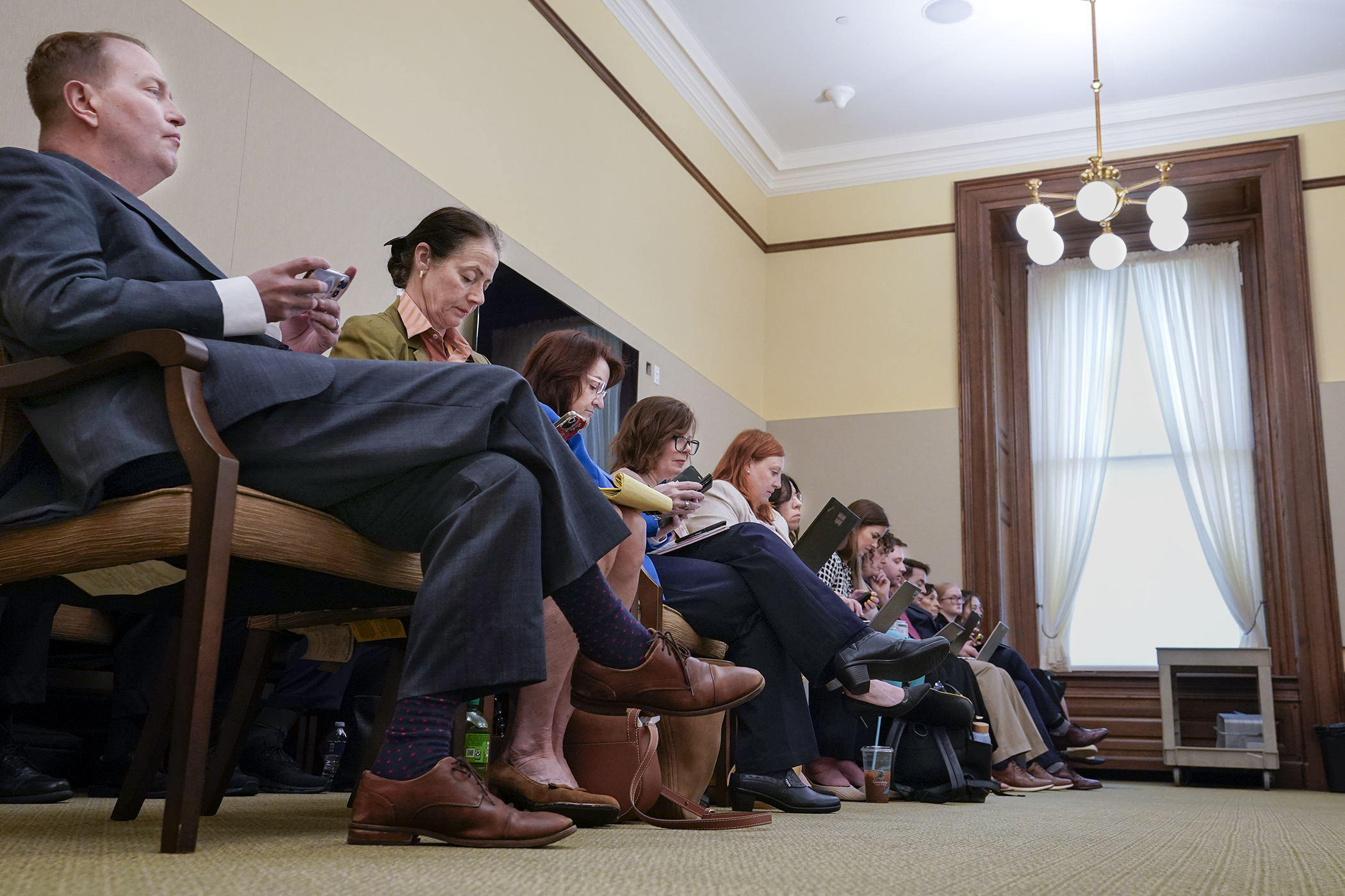Health finance bill moves to House Floor, but MinnesotaCare funding debate looms

— Updated May 9, 2025 to fix spelling error
Like a blockbuster with a planned sequel, the omnibus health finance bill coming from the House Health Finance and Policy Committee ended with “to be continued.”
It leaves unresolved the plot point of funding for MinnesotaCare.
Funding for the health insurance program for low-income residents is not included in the spreadsheet presented Wednesday, when the bill was heard on an informational basis in the health committee in the morning. About three hours later, it was merged with the omnibus children and families budget bill, HF2436, as amended, and approved by the House Ways and Means Committee in the afternoon and sent to the full House.
Who should be allowed to participate in MinnesotaCare is a sticking point between the two caucuses.
That question wasn’t answered in the delete-all amendment for HF2435, which is sponsored by Rep. Robert Bierman (DFL-Apple Valley), a health committee co-chair with Rep. Jeff Backer (R-Browns Valley).
The $3 billion budget as presented would meet the committee’s target of cutting $50 million in 2026-27 biennial spending from the General Fund for health programs.
Uniform administration of non-emergency medical transportation is expected to save $22.78 million for the biennium. It’s expected the state could also find long-term savings from authorizing a state pharmacy benefits manager for Medical Assistance and MinnesotaCare.
The bill would provide additional funding for some struggling sectors of the health care industry. It would increase dispensing fees for some pharmacies by $1.84 per prescription, increase Medical Assistance payment rates for ambulance services by 13.86% and provide an additional $30.44 million to the Office of Emergency Management Services to help pay for uncompensated ambulance runs.
Most impactful, said Bierman, are provisions that would authorize the state to apply for a Directed Payment Program, which supporters say may provide a lifeline to hospitals. The system would close the gap between the cost of providing care and compensation through Medicaid by shifting more costs of service to the federal government. Forty states use the reimbursement system, but required approval from the federal government is not guaranteed.
Other proposed cuts include $4 million in public health infrastructure pilot project grants; $1 million in sexual and reproductive health care grants; and $674,000 by eliminating appropriations supporting policies to promote diversity, equity and inclusion.
The bill would also require social media platforms to display a mental health warning, developed in consultation with the Health Department. The warning would be displayed on launch of a social media site and require the user to acknowledge the potential for harm.
What else is in the bill?
Among policy provisions in the bill are those that would:
- require parents to be educated on how to recognize and report signs of abuse in infants;
- establish a dementia services program;
- exempt spa pools at private standalone rental units, such as Airbnbs, from health inspection requirements that apply to larger public pools dubbed the “Free the Hot Tub Act”;
- provide $18.9 million to extend access to audio-only telehealth;
- provide an additional $701,000 for the Minnesota Rare Disease Advisory Council;
- add metachromatic leukodystrophy to the newborn testing list;
- remove the sunset of the Newborn Hearing Screening Advisory Committee;
- change the current Maternal and Child Health Advisory Task Force into an advisory committee;
- establish a 15-member health care interpreter work group;
- allow benefit explanations to be transmitted electronically;
- beef up requirements for a public hearing when a hospital curtails or ceases services so the hearing is held in a big enough room and accommodates at least one hour of public testimony;
- expand opportunities for graduates of overseas medical schools to practice in the state;
- establish a certified midwife license; and
- allow people to proactively refuse opioids.
Concerns expressed
While appreciating the bill includes many proposals recommended by the Health Department, Commissioner Brooke Cunningham is disappointed it doesn’t include increases to user fees to licensing boards.
 Stakeholders and community members pack a Capitol hearing room May 7 for a House Health Finance and Policy Committee walkthrough of the omnibus health finance bill. (Photo by Michele Jokinen)
Stakeholders and community members pack a Capitol hearing room May 7 for a House Health Finance and Policy Committee walkthrough of the omnibus health finance bill. (Photo by Michele Jokinen)“Without increasing fees, we will experience delays in serving communities, performing mandatory inspections, and providing technical assistance,” she wrote.
President Lucas Nesse wrote that the Minnesota Council of Health Plans appreciates no increased assessments on health plans or applications for a single-payer program, but establishing a county-administered rural medical assistance program, the non-emergency medical transport carve-out and the state pharmacy benefits manger proposal could negatively impact managed care enrollees.
A proposal to eliminate long COVID grants and appropriations raised objections from multiple members of the public who spoke during the health committee meeting.
Testifying from a power wheelchair, Ben HsuBorger said the correct information could have helped him when he contracted myalgic encephalomyelitis/chronic fatigue syndrome 10 years ago.
“Post-viral illness is not new, but the numbers are new,” he said.
[MORE: Read public response]
***
The following are bills that have been incorporated in part or in whole into the omnibus health finance bill:
- HF27 (Backer)
- HF243 (Bierman)
- HF337 (Zeleznikar)
- HF696 (Backer)
- HF715 (Backer)
- HF794 (Nadeau)
- HF862 (Schomacker)
- HF953 (West)
- HF1010 (Agbaje)
- HF1029 (Torkelson)
- HF1100 (Bahner)
- HF1103 (Hemmingsen-Jaeger)
- HF1289 (Stephenson)
- HF1379 (Baker)
- HF1878 (Keeler)
- HF1913 (Mahamoud)
- HF1934 (Reyer)
- HF2007 (Nadeau)
- HF2057 (Nadeau)
- HF2147 (Schultz)
- HF2242 (Nadeau)
- HF2435 (Bierman)
- HF2557 (Nadeau)
- HF2955 (Backer)
Related Articles
Search Session Daily
Advanced Search OptionsPriority Dailies
Speaker Emerita Melissa Hortman, husband killed in attack
By HPIS Staff House Speaker Emerita Melissa Hortman (DFL-Brooklyn Park) and her husband, Mark, were fatally shot in their home early Saturday morning.
Gov. Tim Walz announced the news dur...
House Speaker Emerita Melissa Hortman (DFL-Brooklyn Park) and her husband, Mark, were fatally shot in their home early Saturday morning.
Gov. Tim Walz announced the news dur...
Lawmakers deliver budget bills to governor's desk in one-day special session
By Mike Cook About that talk of needing all 21 hours left in a legislative day to complete a special session?
House members were more than up to the challenge Monday. Beginning at 10 a.m...
About that talk of needing all 21 hours left in a legislative day to complete a special session?
House members were more than up to the challenge Monday. Beginning at 10 a.m...